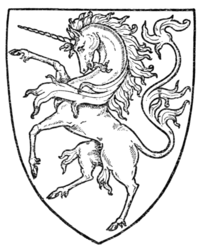"Spenser, in the 'Faerie Queen,' thus describes a contest between the unicorn and the lion:—
- 'Like as the lyon, whose imperial powre
- A proud rebellious unicorn defyes,
- T'avoide the rash assault and wrathful stowre
- Of his fiers foe, him to a tree applies.
- And when him running in full course he spyes
- He slips aside; the whiles that furious beast
- His precious horne, sought of his enimyes,
- Strikes in the stroke, ne thence can be released,
- But to the victor yields a bounteous feast.'
"'It hath,' remarked Guillim, in 1600, 'been much questioned among naturalists which it is that is properly called the unicorn; and some have made doubt whether there be such a beast or no. But the great esteem of his horn in many places to be seen may take away that needless scruple.'
 Fig. 414.—Unicorn rampant. |
 Fig. 415.—Unicorn passant. |
 Fig. 416.—Unicorn statant. |
"Another old writer, Topsell, says:—
"'These beasts are very swift, and their legs have not articles. They keep for the most part in the deserts, and live solitary in the tops of the mountaines. There was nothing more horrible than the voice or braying of it, for the voice is strained above measure. It fighteth both with the mouth and with the heeles, with the mouth biting like a lyon, and with the heeles kicking like a horse.'
"Nor is belief in the unicorn confined to Europe. By Chinese writers it is characterised as a 'spiritual beast.' The existence of the unicorn is firmly credited by the most intelligent natives and by not a few Europeans. A very trustworthy observer, the Abbé Huc, speaks very positively on the subject: 'The unicorn really exists in Tibet.... We had for a long time a small Mongol treatise on Natural History, for the use of children, in which a unicorn formed one of the pictorial illustrations.'"
The unicorn, however, as it has heraldically developed, is drawn

